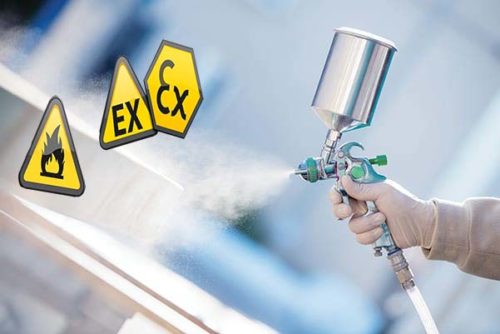Explosion Protection Document
Objective
An Explosion Protection Document (EPD or ESD) lays down the hazards and risks with respect to the occurrence of explosions within companies.
What is the minimum content of an EPD?
The Explosion Protection Document must contain at least the following information:
- An identification and assessment of explosion risks;
- how workplaces and work equipment, including warning devices, are designed, used or operated and maintained with due regard for safety
- which areas have been classified into zones;
- if work is performed by several employers in workplaces, the way they work together and the objective, the measures and the manner of implementation of the coordination of those companies working together in hazardous areas.
Summarised, this means that the explosion protection document must describe the explosion risks within the company, where they may be present and what specific measures have been or will have to be taken, in order to adequately control explosions.
When is an explosion protection document mandatory?

An explosion protection document is an obligation, and in Europe based on Directive 1999/92/EC. This Directive aims to provide safe working conditions for employees and indicates the obligations of employers in particular. The drawing up of an Explosion Protection Document should actually always be done as soon as one of the situations below occurs. Often, the general Risk Inventory and Evaluation will also say something about whether or not to draw up an EPD. It is not always possible to specify a clear lower limit for the quantity of flammable substances present, but national guidelines can specify minimum quantities. These limits are not very strict, because the employer remains responsible for safe working conditions at all times.
Key indicators for having an EPD
The following principles are guiding principles with regard to the need to draw up a EPD.
- As soon as flammable liquids are processed, used or present within the company;
- As soon as flammable gases are processed, used or present within the company;
- As soon as flammable and relatively large quantities of dusty products can occur within the company.
Step-by-step plan for drawing up the explosion protection document
The step-by-step plan for drawing up the explosion protection document is as follows:
a. Inventory of workplaces, work equipment and installations:
-
- Mapping out the various processes and making an inventory of the relevant workplaces and/or internal transport routes
b. Determining the ATEX danger zones
-
- Based on the data obtained, the ATEX zone classification will be determined on the basis of relevant standards and guidelines. The method used for this depends on the situation/installation.
Examples of standards that can be applied are the European standard EN-IEC 60079-10 series, the EI15, API500, NFPA 497, BGR 104 or specific standards for e.g. spray booths, battery loading areas or wood dust extraction.
We often use the software tool Hazcalc for the area classification of flammable liquids and gases.
-
- the zone classification is drawn (Autocad) on a plan of the location and the installations present.
c. Defining measures to limit the zones / hazardous areas
-
- It shall be examined whether it is practically possible to limit the zoning (if the zoning is limited, the rules concerning the machines, equipment and electrical installations to be used will be less strict!)
d. Performing a risk analysis (ignition analysis)
-
- Mapping and assessing the technical data of the installations/work equipment; the possible ignition sources in the zoned areas will be inventoried. The NEN-EN 1227-1 is used as a basis for this.
- A risk analysis will be carried out in which the probability of the ignition of an explosive atmosphere and its possible effect will be estimated.
- This will make a distinction between high risks and low risks.
e. Defining control measures
-
- Based on the results of the risk analysis (steps a to d), the current control measures (technical/organisational) will be checked and, depending on the results, additional measures will be determined.
f. Report
-
- The results of the assessments as described above, will be drawn up in an Explosion Protection Document.
What are the costs of an Explosion Protection Document?
Costs
The costs of an explosion protection document (EPD) depends entirely on the amount of work to be done. It is understandable that an EPD for a woodwork shop or paint shop involves less work than drawing up an EPD for a chemical plant.
Ask for a an estimations of the cost or quotation without obligation!
On the other hand, employers should not be blinded (entirely) by the costs of drawing up an EPD. A cheap EPD is often drawn up in less time than a more expensive one. As always, it is the quality of the EPD that matters: a quick and cheap assessment often leads to fairly wide hazardous areas / ATEX zones. The reason for this, is that such an assessment (especially the determination of the zones) will be based on more assumptions and therefore “safe margins” will be maintained. This can lead to unworkable situations after the EPD has been drawn up, or too many costs being incurred in order to meet all the requirements (e.g. replacement of electrical installations, drawing up work procedures and instructing employees). By spending more time on a proper assessment and determination of the zones, unrealistic measures and excessive costs can be avoided in the follow-up phase.
Our approach
In the past 15 years, we have made assessments and Explosion Protection Documents (EPD’s) for many companies in various branches. Examples include water waste treatment plants (biogas), paint shops, pharmacy, wood processing, chemistry, automotive, bulk storage and transport, animal feed industry, etc.
Our working method is characterised by a practical approach with clear and unambiguous assessments. We are particularly critical in determining the hazardous areas. This is the first important step in determination of the potential explosion hazards. When hazardous areas can be avoided (or can be prevented with relatively simple measures!), no further measures (and therefore no costs) need to be taken to reduce explosion risks.
Working method
In drawing up the explosion protection document, we assess the work processes on site:
- For the possible release of relatively large quantities of flammable substances.
- Based on this, and on the ventilation facilities present, we determine the danger zones.
- All this is of course well documented so that everything can be traced.
- We also draw the danger zones on a map of the relevant work locations.
- Next, we will map out the possible ignition sources in these danger zones.
- On this basis, we determine the minimum measures to be taken in order to control the explosion risks.
- Everything is worked out in the explosion safety document. The result of our work is characterised by a practical document, without too much “ballast”, but with practical advice where necessary.An example of our explosion safety document is shown below.
Your EPD, our competence!
With the experts of Pol-Safety, the EPD is always drawn up and/or checked (and signed) by an IECEx 05 certified Senior Explosion Safety Expert.
More information or a quotation?
For more information or a more detailed explanation, please contact us without obligation. We can often give you an estimate of the necessary work and costs after a telephone call.

